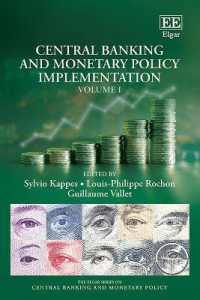- ホーム
- > 洋書
- > 英文書
- > Business / Economics
Full Description
The traumatic experiences of the first half of the twentieth century helped shape the postwar global architecture, which saw the creation of the IMF, the GATT, and the World Bank. Today, this economic architecture is ill-fitted to the global economy. The balance of financial power has moved towards the emerging economies, especially those in Asia, a shift which is not sufficiently reflected in the governance of these institutions.
New Global Economic Architecture addresses how a regional architecture, particularly in Asia, can induce a supply of regional public goods that strengthens the global public goods supplied through the global architecture, to promote sustainable economic development. The global network is moving towards a decentralized system with global, regional, and national institutions, and the book presents a comparison of the pace of reforms in various institutions and the identification of the reform agenda from an Asian perspective. It provides suggestions for strengthening regional institutions in Asia so they may better provide regional public goods. The evolution of institutions and policies that comprise the international monetary, financial, trade and development architecture is considered since their establishment after the Bretton Woods conference of 1944.
Policymakers, academics, think tanks and practitioners will benefit from the international perspective of the book, particularly those interested in the influential Asian architecture. This book is also a useful reference tool for students of macroeconomics, development economics, international trade, and finance at both undergraduate and graduate levels.
Contributors: A. Chabchitrchaidol, A.F. Cooper, H. Hill, M. Kawai, J. Menon, P.J. Morgan, V. Nehru, M.G. Plummer, F. Prada, P.B. Rana, R. Siregar, G. Wignaraja
Contents
Contents:
Preface
1. Asian Perspectives on the Evolving Global Architecture
Masahiro Kawai, Peter J. Morgan and Pradumna B. Rana
2. From a Centralized to a Decentralized Global Economic Architecture: An Overview
Pradumna B. Rana
3. The Group of Twenty: Input and Output Legitimacy, Reforms and Agenda
Andrew F. Cooper
4. Enhancing the Effectiveness of CMIM and AMRO: Challenges and Tasks
Reza Siregar and Akkharaphol Chabchitrchaidol
5. Financial Safety Nets in Asia: Genesis, Evolution, Adequacy and Way Forward
Hal Hill and Jayant Menon
6. Regional Financial Regulation in Asia
Masahiro Kawai and Peter J. Morgan
7. Evolving Trade Policy Architecture and FTAs in Asia
Masahiro Kawai and Ganeshan Wignaraja
8. The Emerging "Post-Doha" Agenda and the New Regionalism in the Asia-Pacific
Michael G. Plummer
9. The World Bank and the Asian Development Bank: Should Asia Have Both?
Vikram Nehru
10. World Bank, Inter-American Development Bank, and Subregional Development Banks in Latin America: Dynamics of a System of Multilateral Development Banks
Fernando Prada
Index







